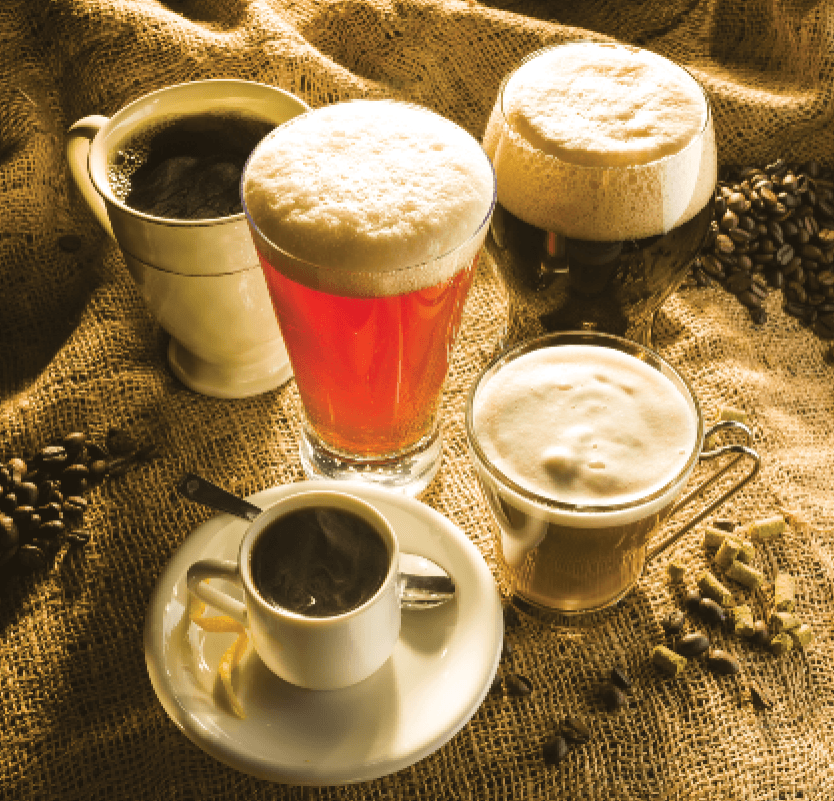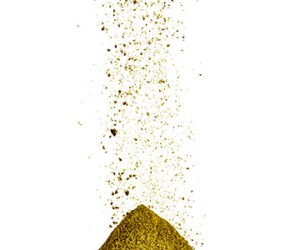Brewing with Coffee

The National Coffee Association claims that 79% of the adult population of the United States drinks coffee regularly. But what those statistics don’t reveal is how many get their coffee through the beer they drink. Of course, why would they even think to ask? Coffee isn’t exactly the most popular beer flavoring, lagging way behind raspberries, cherries and even chocolate. For those who flavor their beer with coffee, however, the results can be very rewarding. A java-laced brew adds a rich aroma and delightful complexity, characterized by heightened mouthfeel, to any brew. It might not be the best drink for breakfast, but who’s going to stop you?
There are two ways to get coffee flavors in your beer — with coffee or without. Most stouts and porters are brewed with highly-toasted barley malts, chocolate malts and black patent malts for flavor and creaminess. It is the deep roasting of these grains that give the darker beers hints of coffee-like flavors. That rich roasted taste and aroma lends itself naturally to coffee, which is also roasted to release essential oils and produce enticing flavors. Pyramid Espresso Stout is a good example of a coffee-flavored beer that relies on roasted malts, has a slight coffee flavor, but doesn’t actually use coffee. But we are after the real thing, right?
The first issue that always arises when brewing with coffee is how potent that java flavor should be. This leads to a second question — how much coffee should be used? Naturally, it all depends on how strong a coffee flavor is desired. Using more coffee, of course, means more pronounced flavors and aromas. However, using too much might overwhelm the brew and leave you with a five-gallon batch of fizzy coffee. Using less coffee means more subtle flavors, but maybe without enough of the coffee characteristic coming through. Don’t let worries about caffeine content keep you from using enough coffee. The caffeine in each glass of beer is so minute that before you could drink enough to get that java buzz, you’d most likely already be passed out from the beer.
The style of beer will also make a difference. As mentioned above, stouts and porters do very well with coffee, but also are strong-flavored as is. More coffee is required for a good balance. But if you seek to create “Pale Coffee Ale,” less coffee might be in order so the classic pale ale flavors are not obliterated. Kavove Pivo is a coffee-flavored lager brewed at the Restaurace Pivovarsky Dum in Prague, Czech Republic, which proves it is possible to work with coffee and any style.
After reviewing dozens of recipes, it seems there is no right or wrong answer to how much coffee should be used, or for that matter when the coffee should be added. One five-gallon (19 L) recipe called for 50 one-ounce (30 mL) shots of espresso added to the wort before pitching. Another recipe listed eight shots added to the secondary. Both reported satisfactory tastes and results. Other recipes require anywhere from a quarter pound (0.1 kg) to 1-3/4 pounds (0.8 kg) of coffee, either whole bean, ground or brewed. The best thing to do is simply experiment, but keep an exact record — so when that world-class brew appears, you’ll be able to reproduce it time after time.
Another consideration is that the type of coffee also plays a role in the flavors, mouthfeel, head retention and hops usage. Using a strong coffee such as espresso or French roast will provide a richer coffee essence, while lighter blends like Sumatra or Guatemala Antigua will bring out more subtle qualities. However, many of the darker roast coffees have a higher oil content brought on by excessive roasting. These oils will add “thickness” and creamy mouthfeel, but can reduce head retention. On the initial pour, the beer foams up but it very quickly dissipates. Using flavored coffees can also add interesting flavor notes and aromas. Chocolate mint or chocolate macadamia nut coffees work well with porters, adding sweetness and nuttiness to a brew. For an even more varied example, try a Southern pecan brown ale. Additionally, some coffees — such as Italian and French roasts — are very bitter. This will affect the amount of hops used. A good rule of thumb is to slightly decrease the hop content by five to eight IBUs and keep bitterness in check. Under-hopping will help control the bitterness while allowing coffee to contribute to the flavor structure. Of course, if you prefer bitter beers, then you may not want to decrease the amount of hops in your beer. It’s up to you.
How Much Joe Adds the Right-Sized Jolt?
The next two entirely subjective questions are these: How and when should the java be added to the brew? This too depends on individual tastes. The “how“ options are simple: whole bean, ground, crushed, brewed, specialty brewed (espresso) or in concentrated extract form.
When using beans in any form, it is best to place the beans in a grain bag, whether steeping the grains or adding them in the boil or fermentation. This makes racking easier — no clogged siphon tubes — and reduces the clean- up mess. A fine ground that is not bagged can get through the siphon tube. But, whether going to the secondary or bottle, these remains may add more coffee flavor than desired. If the bag is loose filled — that is, left with plenty of air space and not condensed — there should be a high surface contact ratio of beer to bean. Some brewers prefer to add the beans directly to either the boil or fermenting stages, thinking this will increase the coffee-ness of the beer, but actually it can be more difficult later when trying to get the grounds out of the spent keg. The state of the beans is also up for debate. Though whole beans are an option, some brewers prefer using coffee beans that have been lightly, medium or course ground, or crushed (ground just enough to break open the beans). Either way, this will increase the contact ratio and heighten flavors.
There is the belief among some brewers that using freshly-brewed espresso will add the best flavors to any beer. This relates to the special hot- water pressure process used to bring out the best in the bean and produce a powerfully small cup of joe.
For those without an espresso machine, the only other option is to brew a “regular” batch of coffee. This can be done with a machine or through a cold seep method. To do this, simply place the ground coffee into a grain bag and soak the bag in cold water for a couple of days.
Remember, this brew — however you make it — will eventually go into the beer. Have a sanitized container ready to hold the coffee until the time comes to add it to beer. Furthermore, it is best to find the freshest coffee available, and this does not include instant coffee or canned coffees like Folgers. These “freeze dried” coffees, though sealed quickly after being ground, cannot offer the freshness and superior flavors of gourmet coffees. Brewers have also reported this style of coffee can produce off-flavors in the beer.
Perhaps the easiest way to attain coffee flavors is through an extract. Moka Liqueur Extract, a coffee-flavored extract used to produce homemade Kalhua, is one possibility, while coffee oils are available at health food stores, though the oils may effect head retention. Homebrew shops may also carry extracts.
Though not commercially available, Starbucks developed an extract that would work well with their ice cream and Frappuccino drinks. Created from a Central American blend, it became the flavoring for the now-extinct Double Black Stout from Redhook Breweries in Seattle, Washington. The extract is derived from a cold-water concentrating process that is designed to bring out more of the positive side of the coffee and keep the bitterness in check. When added to an Imperial Stout recipe, the popular — though short-lived — brew was born.
“Being a Seattle brewer and lover of coffee, it seemed a logical extension to take the traditional use of high roasted malt in dark beers and replace some of those malt notes with coffee,” explained Doug McNair, Redhook’s master brewer and creator of Double Black Stout. “What we used was essentially a very strong coffee, not unlike an espresso, in concentration. As a home- brewer I would use exactly that — make some espresso, not necessarily with espresso beans, and add it during or after your primary fermentation.”
Putting the Java in the Brew
Now we’re back to the second question: when to add the coffee? It seems coffee can be added pretty much anytime: steeped with the grains at the start, during the boil, in the primary or secondary fermentation or just before bottling. With each method coffee flavoring will be attained, though there are some differences. With earlier additions, such as in the steep or boil, some overall coffee characteristics may be “washed out,” resulting in a more subtle aroma and flavor in the finished beer. Later additions — in the primary or secondary fermenter — will lead to more robust coffee expressions, but may be overpowering for some beer drinkers.
One method is to slowly steep the coffee with the grains. This will allow plenty of time for the coffee flavors to reveal themselves. Some brewers claim this adds even more complexity while stifling some of the bitterness. Most brewers do agree that if coffee is added to the boil it should be near the end, the last 10 minutes. This allows the coffee enough time to “brew” with the wort and release its flavors. Even pre-brewed coffee can be used at this time with good results. This is what Russ Klisch does for his “Lakefront Fuel Café Coffee Flavored Stout,” produced at his brewery in Milwaukee. Klisch uses the cold-seep method with a secret blend from a local coffee shop. The coffee is then added “somewhere near the end of the boil.”
“This was the biggest challenge in the project . . . to get a harmonious roast note from the coffee without picking up the harsh acidic flavors,” added McNair. “I found that mash or kettle additions always picked up way too much harshness, not unlike that office pot of coffee that has been sitting around too long. We settled on doing the additions on the cold side in the cellars (secondary fermentation) and the results were much better — nice roasted characters blending with the roasted malt flavors to yield a complex multi-layered flavor profile.”
As recommended by McNair, the coffee can be added to the primary or secondary. That allows the coffee flavors more time to merge with the beer and create the right characteristics. With that in mind, the extract, which should be mixed with three to four cups of brewed coffee, should not be added during the boil, but rather to the primary or secondary. There is also the option of adding brewed coffee right before bottling. The homebrew will have strong coffee notes and aromas that will develop during bottle conditioning. This also can be achieved with kegging. It may be possible to add whole or crushed beans to each bottle, but this can introduce bacteria that will spoil the beer.
Using coffee in beer should not increase fermentation or conditioning times. Like most beers, however, the longer the bottle conditioning, the more noticeable the brew flavors and characters. The beauty in creating coffee flavored brews, no matter which brewing method you follow, is the irresistible coffee aroma right off the top, the creamy head and a richly complex beer with delicious coffee hints in every sip. One final tip: for the ultimate in presentation, serve your coffee flavored beer as they do at Restaurace Pivovarsky Dum, with an espresso bean resting neatly on the foamy head. What could be more fitting?
RECIPES
Coffee Imperial Stout
(5 gal/19L, all-grain)
OG: 1.067 FG: 1.016
IBU: 70 SRM: 35
by Doug McNair, Redhook Breweries
Ingredients
- 8.0 lbs. (3.9 kg) 2-row pale malt
- 2.25 lbs. (1 kg) crystal (60–80° L)
- 1.5 lbs. (0.7 kg) wheat malt
- 1.25 lbs. (0.6 kg) chocolate malt
- 0.5 lb. (0.2 kg) roasted barley
- 0.5 lb. (0.2 kg) black patent malt
- 18.75 AAU Northern Brewer hops (bittering)
- (2.5 oz./71 g of 7.5% alpha acids)
- 1.5 oz. (42 g) finishing hops
- (Northern Brewer or Cascade)
- 15 oz. (445 mL) of espresso
- Ale yeast (your choice)
Step by Step
Mash in all grains at 149° F (65° C). Hold until converted, about 1 hour. Mash off at 170º F (77° C) and begin lautering. Sparge to achieve eight gallons (30 L) of wort. Bring to a boil and add 2.5 oz. (71 g) boiling hops. Total boil is 70 minutes. After the boil, turn off the heat and add 1.5 oz. (43 g) finish hops for five minutes. Cool to 70º F (21° C) and ferment with ale yeast. Original gravity goal is 17.5° Plato (1.069 SG). Terminal gravity will be pretty high, approximately 1.016. Add espresso at end of primary fermentation, bottle and enjoy!
Buzz’ard Double Chocolate Espresso Stout
(5 gal/19L, extract with grain)
OG: 1.072 FG: 1.020
IBU: 56 SRM: 35
by John Arthur and Glenn BurnSilver
Ingredients
- 8 lbs. (3.6 kg) Alexander’s dark malt extract syrup
- 0.5 lb. (0.2 kg) crystal malt (120 °L)
- 0.5 lb. (0.2 kg) chocolate malt
- 0.5 lb. (0.2 kg) roasted barley
- 1 lb. (0.45 kg) Ghirardelli Select Brown chocolate powder
- 15 AAU Northern Brewer hops
- (2 oz./57 g of 7.5% alpha acids)
- 0.5 lb. (0.2 kg) espresso beans, fine ground, brewed to 1 gallon
- (3.8 L) of coffee
- Wyeast 1056 (American Ale) yeast
Step by Step
Place grains in 2.5 gallons (9.5 L) of water, heat to 170º F (77° C), let sit for 25 minutes. Return to boil, dissolve extract. Return to boil. Add 1-1/2 oz. (43 g) hops and chocolate (add slowly and stir constantly so it doesn’t stick and burn on the bottom). At 45 minutes add 1/2 oz. (14 g) hops. At 60 minutes, turn off the boil. Chill to 88° F (31° C) and add to carboy with 1-1/2 gallons (5.7 L) water. Pitch yeast (built up as a one-quart starter with DME) at 78º F (26° C). After primary is complete, rack to secondary, store in cool place (below 60º F or 16° C) for 45 days. Rack to bottling bucket, add one gallon (3.8 L) room temperature coffee and 3/4 cup bottling sugar. Stir well to mix and then bottle.
Mudhouse Stout
(5 gal/19L, all-grain)
OG: 1.052 FG: 1.014
IBU: 25 SRM: 35
by Ashton Lewis, Springfield (Missouri) Brewing Company
Ingredients
- 8 lbs. (3.6 kg) 2-row pale malt
- 0.25 lbs. (0.11 kg) Hugh Baird crystal malt (50 °L)
- 0.25 lbs. (0.11 kg) Hugh Baird chocolate malt
- 0.50 lbs. (0.23 kg) Hugh Baird roasted barley
- 0.50 lbs. (0.23 kg) Weyermann Carafa III
- 4.1 AAU Nugget hops (bittering)
- (0.33 oz./10 g of 12.5% AA)
- 0.50 oz. (15 g) Cascade hops (flavor)
- 1.0 oz. (27 g) Cascade hops (aroma)
- 21 oz. (620 ml) fresh brewed coffee
- White Labs WLP001 (California Ale)
Step by Step
Mash grains at 155–158º F (69–70° C) for 60 minutes. Sparge with water at 168º F (76° C) and collect enough wort so that you end up with 5 gallons (19 L) after boiling. Total boil is 90 minutes. Bring to boil, add Nugget hops for 70 minutes, and remove. At 60 minutes, add first Cascade hops. Turn off heat. Add second Cascade hops. Ferment at 64º F (18° C). Primary takes three days. Do a two-day rest at 64º F (18° C) after primary is complete, cool to 52º F (11° C) and then hold for four days. Then chill to 32º F (0° C) and hold for at least one week. Coffee is added when the beer is down to 32º F (0° C). Add 21 oz. (620 mL) of fresh hot coffee, brewed from 1-1/4 oz. (35 g) espresso roast, to the cold stout. After a week, bottle.



